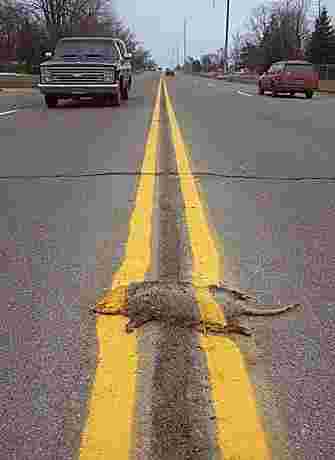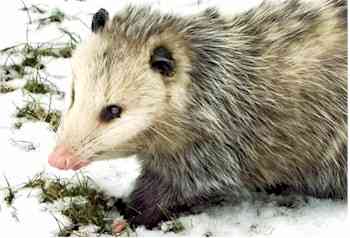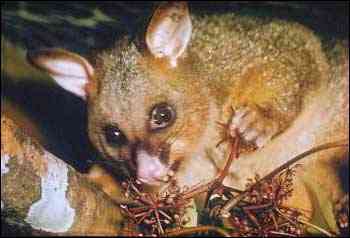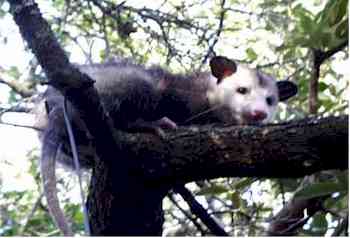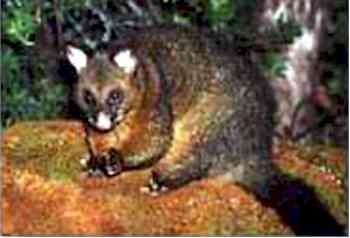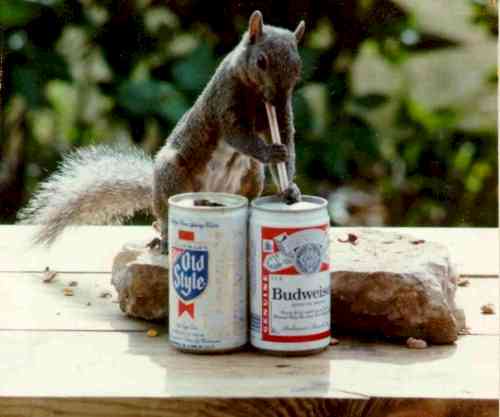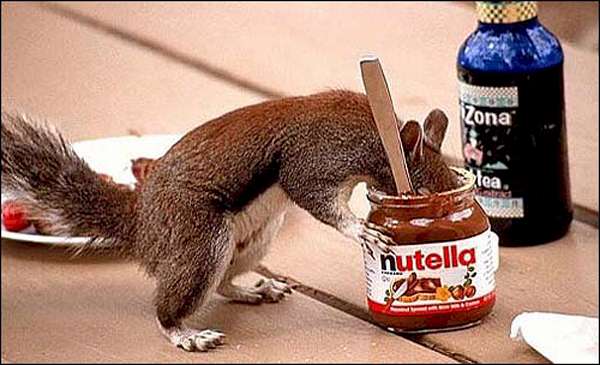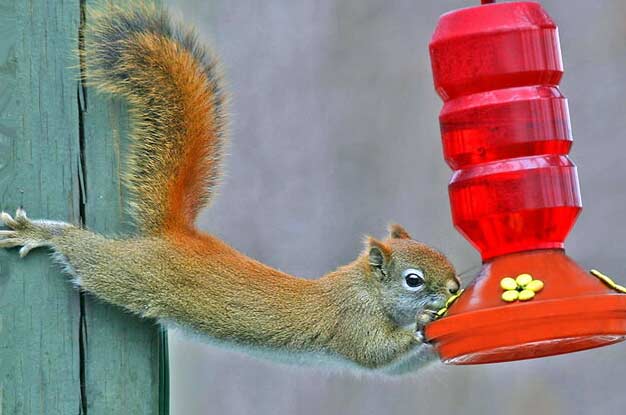That Possum Looks Awesome
This Possum Isn't PlayingYou can't be suspicious of a tree, or accuse a bird or a possum of subversion or challenge the ideology of a violet. - Hal Borland The furry brown opossum gazed thoughtfully with its large brown unblinking eyes at the intense beam of light that was directed at him and ruminated quietly as to what this light might signify. Source: Steve Wyn-Harris, Waipukurau, as quoted in Dr Brian Edwards' Top of the Morning Worst First Sentence of a Novel Competition 1999
Couple Want Law Change to Make Eating Roadkill LegalAn Oregon couple are petitioning authorities for the right to eat roadkill. Sheila Clauson and John Wakeman of Crook County say it's unfair people can't salvage animals killed or injured by cars for food. It's currently against Oregon law. The animals must be dealt with by wildlife officials. Ms Clauson told the Bend Bulletin, "We're proposing that a normal, everyday person be able take an animal that's been hit by a car - after calling the authorities - and use it." Ms Clauson and her husband have started a petition aimed at changing the law. The law states that taking an animal, like an elk or deer, is considered tampering with evidence and illegal possession of wildlife. Ms Clauson says her husband recently found an injured buck. He called authorities but was told not to put the animal out of its misery or take it anywhere. The animal died before wildlife officers arrived and its carcass was not removed until a day later. Ms Clauson says she could have used the meat. She also thinks carcasses could attract coyotes or cause other accidents. "The point is it made us mad," she says. "Here we have perfectly good meat sitting on the side of the road and you can't touch it." Source: www.ananova.com Wednesday 12th December 2001
This Could've Been Lunch
Source: The Web Actually, that the possum might've been lunch isn't all that far-fetched. See a recipe for stuffed opossum in the Lifestyles section. (And that page links to a site containing recipes for armadillo, crow, skunk, and other roadkill yummies...)
Up Over and Down Under PossumsThe two opossoms on the left below are American. The two on the right are Kiwis. (I think the down-under possums are cuter.) The upper pictures show the faces better while the lower ones show the hairless/hairy tail difference more clearly. When I was younger, I had a neighbour with a possum (the American kind) for a pet. She said the animal was trained to use a catbox and was intelligent and pleasant. A search for New Zealand possums on the internet turns up sites for poisoning, skinning and cooking them. They aren't well thought of because they've proven too successful in their new country (they were introduced in the early part of the 20th century). They are now destroying the beautiful native pohutakawa trees (and others).
Possums, Number One Pest, Become Dog FoodWellington - Possums, New Zealand's number one pest, are going to the dogs. "Possyum," a canned pet food made from possum meat, is the brainchild of New Zealand farmer Bryan Bassett-Smith, who plans to break into the markets of Singapore and South Korea. The possum, a cat-sized tree-climbing marsupial from Australia, was introduced into New Zealand in 1837 to establish a fur trade. But with their population now topping 70 million - 20 times the number of New Zealanders - the furry pests represent a danger to native forests, chomping through an estimated seven million tonnes of vegetation a year. The new petfood is already being sold in New Zealand and the company is now eyeing the lucrative export markets of Singapore and Korea, Bassett-Smith told Reuters. He developed the product with the help of a government grant. "It smells and tastes very much like a good corned beef. It's got a nice odour to it and dogs just go quite bananas over it," he said. A network of trappers collect the possums for canning. Possum is not widely eaten by people in New Zealand although several restaurants have served up possum pie as a novelty item. Efforts are also being made to farm possums for their meat to Taiwan, Hong Kong and Malaysia for human consumption as Kiwi Bear. Source: dailynews.netscape.com Wednesday 11 July 2001 from Reuters
-------- Original Message -------- Dear Ruth, We just came back from a 3 weeks vacation from New Zealand. During a trip to Milford Sound with one of the tour operators, we were offered BBQ possum amongst other meat. I would like to know if consumption of possum is a usual practise in your beautiful country or in any case endanger one's health. Yours sincerely, See also:
Don't Go Acting Squirrelly!
Source: Left picture: the web; right picture: www.thesun.co.uk sent to them by Carly Porter
Squirrel Having Fun
Click to Play Source: youtube.com
I know squirrels are pests, but they can also be amazingly clever. I found they were one of the few things I actually missed about the US...
If You Go Down to the Woods Today...by Richard Askwith To some, they're charming, gentle creatures. To others, they're a threat to property, livestock - and people. Either way, there are more badgers about than ever, and a fierce war of words is raging over their reputation. The first time a young badger bounced down the garden to greet me, I felt a flush of pride. Presumably it had mistaken me in the dark for a fellow badger - it bolted the second it realised its error. But it was still gratifying, as if its snuffling at my feet conferred some kind of seal of approval from the natural world. Who knows, I thought: perhaps I could become a badger whisperer? Over the years, though, my attitude to the black-and-white burrowers that live beneath our garden shed has soured. This is partly because of the shed, which I expect to collapse any day now into the vast emptiness that the badgers have created under it. Partly, too, it's because of the garden, whose neatish lawn has been transformed into a ploughed field by the relentless depredations of our inconsiderate cohabitants. Every night, they wrench dozens of great divots from it in pursuit of grubs and worms, leaving holes that are a proven hazard to human ankles. What I really resent, though, is the fact that I no longer dare let the children camp unattended in the garden. Parental paranoia? Perhaps. Badgers are not known for attacking humans; on the contrary, they have a reputation as shy, inoffensive creatures that flee at the first whiff of human scent. Yet the idea that they might have a more dangerous side is not so far-fetched as it might once have seemed. Ask Michael Fitzgerald, who last month found a badger in his garage in Evesham, Worcestershire, tried to photograph it and was viciously mauled. The badger lunged at him, slicing its teeth into his arm and his leg. "The house looked like a slaughterhouse," said the 67-year-old former BBC editor, who spent four days in hospital receiving skin grafts. "There was blood everywhere." You probably read about that one. The press relished the "Bonkers Badger Maims Five" headlines, and devoted plenty of space to recounting how Boris - as the beast used to be known before it escaped from the nearby Vale Wildlife Rescue Centre - had also injured seven other locals, four of whom required hospital treatment. But other recent tales of badger bother may have passed you by. For several weeks, for example, residents of Tredworth, Gloucester, have been complaining of a ferocious elderly male badger that has been rampaging in their neighbourhood at night. He has yet to draw blood, but he has ripped down fences and plants, put teeth-marks in a wood-and-brick barricade, and left a trail of fear. Residents, who have christened him "Trouble", claim to be terrified. "I'm scared to go out at night with that thing there," said 55-year-old Marjorie Dennis. "I wouldn't want to be out there with it," said her neighbour, Mike Roberts. "It was huge." Back in January, meanwhile, a whippet belonging to 90-year-old Joan Reynolds had its throat ripped out near Llangadog in Carmarthenshire. The attack was initially attributed to a "big cat", but tests by the Government's Central Science Laboratory suggested that a more likely cause of death was a badger-fight. Two days earlier, Jill Bowen-Bravery, a farmer from Upper Llanover, Gwent, reported that her seven-year-old collie had been horribly savaged by a badger right outside her back door. The dog lived, but required 64 stitches. "Her skin was ripped from her stomach to her backside," said Bowen-Bravery. "But the really worrying thing is that if it had been our three-year-old granddaughter playing outside the back door she would be dead by now." Do you blame her for having such concerns? It depends on your prejudices. Animal-lovers for whom it is an item of faith that wild mammals can do no wrong will bristle at any suggestion that badgers could pose a threat to human wellbeing. Others - notably in the farming lobby - will welcome anything that redounds to the creatures' discredit. Members of that dwindling minority who keep an open mind on such matters might prefer simply to ask a few tentative questions. Are Britain's badgers becoming delinquent? Are they blacker than they have hitherto been painted? Is this confluence of news items coincidental? Or is something going on? The answers are less reassuring than one might hope. First, the points everyone agrees on. There are a lot of badgers about - far more than there used to be. According to the most authoritative figures, Britain's adult badger population grew by about two-thirds between 1985-1988 and 1994-1997, from about 190,000 to 310,000. (Since then, depending on who you believe, it has either remained stable or continued to increase. The Department of Environment, Food and Rural Affairs - Defra - recently claimed that "the population is likely to be in excess of 400,000".) A succession of spring droughts has increased the visibility of this population by forcing badgers to forage further afield in search of worms. And, of course, we see more of them because more of us are living in rural areas. But the main cause of the badger boom is the considerable protection that the creatures now enjoy in law. Under the Protection of Badgers Act 1992 (which built on the 1973 Badgers Act), it is illegal wilfully to kill, injure or "take" a badger; to dig for a badger; to damage, destroy, obstruct access to or cause a dog to enter any structure or place (including sheds, culverts and derelict buildings) displaying signs of use by a badger; or to create various forms of commotion near such structures or places. As a result, a species that 30 years ago was considered endangered has thrived and multiplied to the extent that some now speak of it as a pest. But threats to badgers' wellbeing remain: 50,000 a year die in traffic accidents; about 10,000 are still killed illegally; and a further but variable number (currently about 2,000 a year) are culled by agents of Defra. This brings us to the points that people disagree on. The controversy over badgers and bovine tuberculosis has been raging for decades. Life - or, at least, this article - is too short to go into the detail, except to say that one side - mainly farmers and civil servants - believes that badgers spread bovine TB and should be culled in order to contain it, while the other - selected expert and non-expert mammal-lovers - insists that there is no scientific justification for such a belief or such a cull. In the latest report on the matter by a sub-committee of the Commons Environment, Food and Rural Affairs Select Committee, David Drew, the sub-committee's chairman, neatly summed up the state of debate. "The TB Forum," he complained, "seems to provide an arena for the repetition of entrenched views in which no one is prepared to listen to an opposing view." But the facts remain that bovine TB is on the increase; that farmers insist that a badger cull is the solution; that the biggest and most carefully monitored trial cull to date is in progress; and that partisans on both sides are seizing more eagerly than ever on any scrap of evidence that appears either to vindicate or implicate the animals. Hence the enthusiasm with which the Farmers' Union of Wales reacted to the mauling of Jill Bowen-Bravery's collie: "How many more children and old people have to be maimed by badgers or foxes?" demanded the county executive officer Neil Smith, neatly conflating a recent attack by a fox on a baby with a badger-fight in which no human was involved. "These animals are not cuddly bunnies. They are vicious killers." Hence, too, the abandon with which Robert Key, the Conservative MP for Salisbury, recently told the Commons that "in south-west Wiltshire the badger population is out of control." But the anti-cullers, whose supporters in high places include Geoff Hoon (not otherwise known for his aversion to bloodshed), have been no less ferocious in their lobbying. The National Federation of Badger Groups (NFBG) - in addition to monitoring the state of the nation's setts - relentlessly monitors the accuracy of public statements on the subject and pours scorn on the anti-badger propaganda of the farming unions. "It's like witch-burning," says Dr Elaine King, the chief executive of the NFBG. "They want culling stepped up, but they can't explain how or why. There's no basis in science." One of the NFBG's more impressive coups came last summer, when it exposed a plan by an alliance of pro-snaring groups - including the British Association for Shooting and Conservation, the National Farmers' Union, the Countryside Alliance and the National Gamekeepers' Organisation - to drag the good name of badgers through the dirt. The plan was discussed at a "Snares Consultation Meeting" in April 2002, at which it was agreed that "for media purposes... with care, the excessive popularity of badgers needs to be reversed". With all this briefing and counter-briefing, it's easy to lose sight of the undisputed fact of the badger population boom. But this is in itself a cause for moderate concern. Take a small, crowded island and vastly increase the numbers of a species of large, foraging mammals living on it, and the amount of contact between those mammals and the human population will increase too. Such contact may be largely benign; it is unlikely to be universally so. At least some of last year's 50,000 badger road-deaths must have resulted in damage to cars and, possibly, to people. Similarly, badgers' impact on property has grown, and has not been wholly positive. In a survey by the Central Science Laboratory published in 1999, 57% of farmers stated that badger damage on their land had increased in the past five years. Piran White, senior lecturer at the Environment Department at York University, estimates the cost of such damage at about £30m per year. "This," he says, "is probably about the same as the cost of damage to agriculture caused by commensal rodents [that is, rats and mice] and two to three times higher than the damage cost of foxes." White is in the middle of a long-term badger-conservation research project whose premises include the assumption that "conflicts between badgers and humans, especially in agriculture, are likely to become more significant and more widespread in the next decade". But it's not just farmers who are affected: any land that could contain worms, grubs and beetles, or could accommodate a sett, is vulnerable. Defra receives about 700 applications a year for licences to close setts whose occupants are causing damage, about 10% of which come from private home owners. In some cases, these applications are opposed by badger-lovers. Resolving such conflicts isn't cheap. A Scottish housing developer, Inverness Homes, announced the other day that it is spending £15,000 on two luxury badger setts to ensure that one of its new developments does not inconvenience the badgers there. At Thundersley, Essex, where a colony of badgers has been disturbing graves in St Peter's churchyard for years, parishioners face a bill of up to £500,000 if they opt to relocate the badgers in the approved way. And at Saltdean, in East Sussex, an 18-month dispute over some householders' desire to have a sett closed was only finally resolved when Defra agreed last month to fund the creation of an artificial sett. The cost has not been disclosed, but Elliot Morley, the animal health minister, complained bitterly that none of the lobbying parties was prepared to make a financial contribution. Can a backlash be expected? There are already plenty of country-dwellers who think that Britain has, in effect, become a soft touch for badgers. ("They come over here, they take our worms...") They may be wrong, but it's likely that some are already be taking the law into their own hands, and if levels of perceived damage and perceived injustice continue to rise, others may follow. Other species - bats, for example, and hawks - have had similar experiences. We endanger them, then protect them, then, when they thrive, bitterly resent them. Or, as Piran White puts it: "Occasionally, protection is so successful that populations increase and any conflicts may be exacerbated." And conflicts - particularly violent ones - fuel even more resentment. Somewhere behind all this lies an awkward truth, which decades of Disney films and nature documentaries have lulled us into forgetting: wild animals are wild - and entirely indifferent to our wellbeing. That doesn't mean that badgers are our enemy, or that we cannot enjoy their presence in our lives. (If you've never sat out in the small hours to watch a family of badgers at play, I suggest you try it.) Rather, it means treating them with respect, and facing the fact that, if we insist on promoting the interests of wild animals, we should be prepared for them to intrude on our lives in unexpected, sometimes dangerous ways. Just over a year ago, Sophie and Alice Barnard, then aged nine and six respectively, awoke early one morning to find a badger in their bedroom in St Leonards, East Sussex. It had wandered in through the cat-flap, apparently in search of cat food, before losing its way. There is no reason to believe that aggression was on its agenda, yet it wouldn't have taken much ill-luck for the situation to have turned nasty. The girls' mother sought help from the RSPCA in evicting the intruder; others might not have shown such presence of mind. And, as Tim Thomas, the senior scientific officer for the RSPCA, pointed out: "They've got sharp teeth and incredibly powerful jaws, so it's important that they're left well alone, especially when they've been cornered in a situation like this." Unprovoked attacks such as that by "berserk Boris" are likely to remain vanishingly rare: the RSPCA attributes his aggression to inappropriate hand-rearing, which caused him to lose his fear of humans. But accidental close encounters are likely to increase; and, as Elaine King concedes, "in some cases there will be conflict". The conflicts to worry about are those in which the badgers feel threatened. The question is: will the humans involved have the wisdom to feel threatened themselves? "Badgers are not aggressive and they don't go looking for trouble," says Jill Bowen-Bravery. "I'm very fond of badgers. But if by accident you get in the wrong place and corner a badger, that's very bad news indeed." Source: The Independent (UK) 13 June 2003
For more on animals, including reptiles, crustaceans, arachnids, insects, fish, birds, pets, livestock, rodents, bears, primates, whales and Wellington's waterfront, click "Up"
below to take you to the Table of Contents for this Animals section. |
 Animals
Animals Animation
Animation Art of Playing Cards
Art of Playing Cards Drugs
Drugs Education
Education Environment
Environment Flying
Flying History
History Humour
Humour Immigration
Immigration Info/Tech
Info/Tech Intellectual/Entertaining
Intellectual/Entertaining Lifestyles
Lifestyles Men
Men Money/Politics/Law
Money/Politics/Law New Jersey
New Jersey Odds and Oddities
Odds and Oddities Older & Under
Older & Under Photography
Photography Prisons
Prisons Relationships
Relationships Science
Science Social/Cultural
Social/Cultural Terrorism
Terrorism Wellington
Wellington Working
Working Zero Return Investment
Zero Return Investment